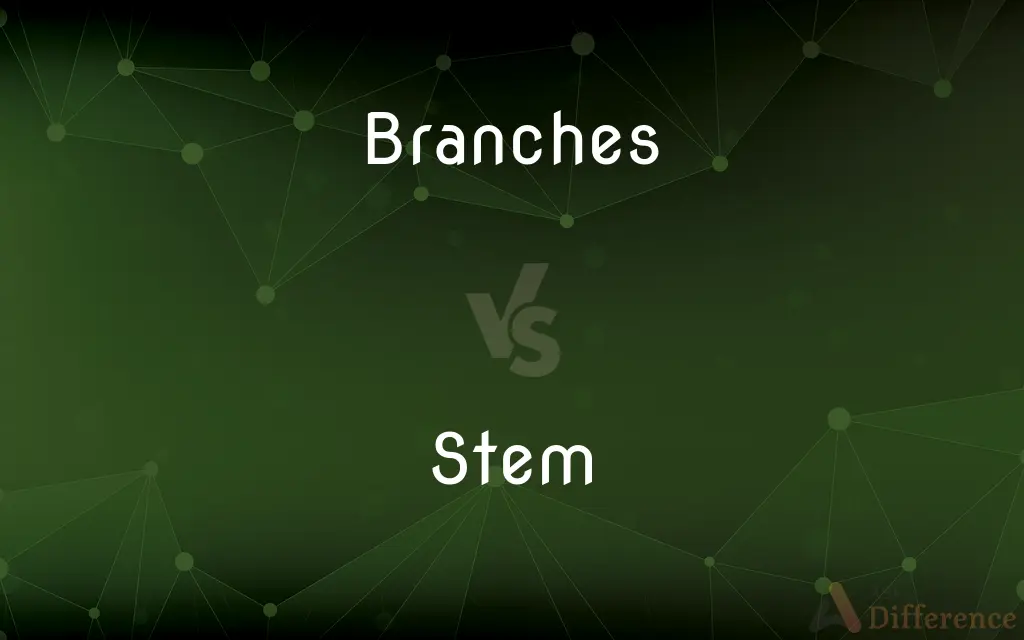Branches vs. Stem — What's the Difference?
By Fiza Rafique & Urooj Arif — Updated on May 17, 2024
Branches are offshoots from the main stem of a plant, growing outwards and typically bearing leaves or flowers, while the stem is the main support structure, transporting nutrients and water between roots and branches.

Difference Between Branches and Stem
Table of Contents
ADVERTISEMENT
Key Differences
Branches extend from the main stem and spread outwards, often bearing leaves, flowers, or fruits. They play a crucial role in the plant's ability to capture sunlight for photosynthesis. The stem, on the other hand, acts as the central support system of the plant, connecting roots to branches and leaves, and facilitating the transport of water, nutrients, and food.
Branches emerge at various points along the stem, creating a network that increases the plant's surface area for photosynthesis. The stem itself, though typically vertical, can vary in length and girth depending on the plant species, providing structural integrity and storage.
Branches can be thin or thick, and their number can vary widely among plant species, influencing the plant's overall shape and growth pattern. In contrast, the stem is usually singular and central, providing a conduit for essential fluids between the roots and the aerial parts of the plant.
Branches may undergo pruning or break due to environmental factors, impacting the plant's growth and productivity. The stem, being more robust and central, is less prone to such damage but crucial for the plant's overall stability and nutrient distribution.
In many plants, branches will bear flowers or fruits, contributing to reproduction and seed dispersal. The stem, although it may sometimes bear flowers, primarily serves to elevate the branches and leaves, ensuring they receive adequate sunlight.
ADVERTISEMENT
Comparison Chart
Function
Extend outwards, bear leaves/flowers/fruits
Main support, nutrient and water transport
Position
Grow from the stem
Central structure connecting roots to branches
Growth Pattern
Vary in number, influence plant shape
Typically singular and vertical
Role in Photosynthesis
Increase surface area for light capture
Elevates branches and leaves
Response to Damage
Prone to pruning or breaking
Provides structural integrity, less prone to damage
Compare with Definitions
Branches
Divisions from the main axis of the plant.
New branches sprouted in the spring.
Stem
The main supportive structure of a plant.
The stem of the sunflower stood tall and straight.
Branches
Extensions that increase surface area for photosynthesis.
The branches spread wide, catching maximum sunlight.
Stem
Central part connecting roots to leaves and branches.
Nutrients traveled up the stem from the roots.
Branches
Secondary woody parts growing from the trunk.
Birds built nests in the branches of the tall oak.
Stem
Structural element providing stability.
The tree's stem was sturdy and unyielding.
Branches
Offshoots from the main stem of a plant.
The apple tree's branches were laden with ripe fruit.
Stem
Primary axis of a plant, supporting other organs.
The stem supported the entire canopy of the tree.
Branches
A secondary woody stem or limb growing from the trunk or main stem of a tree or shrub or from another secondary limb.
Stem
The main ascending part of a plant; a stalk or trunk.
Branches
A lateral division or subdivision of certain other plant parts, such as a root or flower cluster.
Stem
A slender stalk supporting or connecting another plant part, such as a leaf or flower.
Branches
A secondary outgrowth or subdivision of a main axis, such as the tine of a deer's antlers.
Stem
A banana stalk bearing several bunches of bananas.
Branches
(Anatomy) An offshoot or a division of the main portion of a structure, especially that of a nerve, blood vessel, or lymphatic vessel; a ramus.
Stem
The tube of a tobacco pipe.
Branches
An area of specialized skill or knowledge, especially academic or vocational, that is related to but separate from other areas
The judicial branch of government.
The branch of medicine called neurology.
Stem
The slender upright support of a wineglass or goblet.
Branches
A division of a business or other organization.
Stem
The small projecting shaft with an expanded crown by which a watch is wound.
Branches
A division of a family, categorized by descent from a particular ancestor.
Stem
The rounded rod in the center of certain locks about which the key fits and is turned.
Branches
(Linguistics) A subdivision of a family of languages, such as the Germanic branch of Indo-European.
Stem
The shaft of a feather or hair.
Branches
A tributary of a river.
Stem
The upright stroke of a typeface or letter.
Branches
Chiefly Southern US See creek. See Note at run.
Stem
(Music) The vertical line extending from the head of a note.
Branches
A divergent section of a river, especially near the mouth.
Stem
The main line of descent of a family.
Branches
(Mathematics) A part of a curve that is separated, as by discontinuities or extreme points.
Stem
(Linguistics) The main part of a word to which affixes are added.
Branches
A sequence of program instructions to which the normal sequence of instructions relinquishes control, depending on the value of certain variables.
Stem
(Nautical) The curved upright beam at the fore of a vessel into which the hull timbers are scarfed to form the prow.
Branches
The instructions executed as the result of such a passing of control.
Stem
The tubular glass structure mounting the filament or electrodes in an incandescent bulb or vacuum tube.
Branches
(Chemistry) A bifurcation in a linear chain of atoms, especially in an organic molecule where isomeric hydrocarbon groups can vary in the location and number of these bifurcations of the carbon chain.
Stem
To have or take origin or descent
Her success stems mostly from hard work.
Branches
To put forth a branch or branches; spread by dividing.
Stem
To remove the stem of
Stemmed the apples.
Branches
To come forth as a branch or subdivision; develop or diverge from
An unpaved road that branches from the main road.
A theory that branches from an older system of ideas.
Stem
To provide with a stem
Wine glasses that are stemmed.
Branches
(Computers) To relinquish control to another set of instructions or another routine as a result of the presence of a branch.
Stem
To make headway against (a tide or current, for example).
Branches
To separate (something) into branches.
Stem
To stop or stanch (a flow)
Stemmed the bleeding.
Branches
To embroider (something) with a design of foliage or flowers.
Stem
To restrain or stop
Wanted to stem the growth of government.
Branches
Plural of branch
Stem
To plug or tamp (a blast hole, for example).
Branches
Parts of a tree that bear leaves, flowers, or fruit.
The wind rustled the branches of the willow.
Stem
(Sports) To turn (a ski, usually the uphill ski) by moving the heel outward.
Stem
To stem a ski or both skis, as in making a turn.
Stem
The stock of a family; a race or generation of progenitors.
Stem
A branch of a family.
Stem
An advanced or leading position; the lookout.
Stem
(botany) The above-ground stalk (technically axis) of a vascular plant, and certain anatomically similar, below-ground organs such as rhizomes, bulbs, tubers, and corms.
Stem
A slender supporting member of an individual part of a plant such as a flower or a leaf; also, by analogy, the shaft of a feather.
The stem of an apple or a cherry
Stem
A narrow part on certain man-made objects, such as a wine glass, a tobacco pipe, a spoon.
Stem
(linguistics) The main part of an uninflected word to which affixes may be added to form inflections of the word. A stem often has a more fundamental root. Systematic conjugations and declensions derive from their stems.
Stem
(slang) A person's leg.
Stem
(typography) A vertical stroke of a letter.
Stem
(music) A vertical stroke marking the length of a note in written music.
Stem
(music) A premixed portion of a track for use in audio mastering and remixing.
Stem
(nautical) The vertical or nearly vertical forward extension of the keel, to which the forward ends of the planks or strakes are attached.
Stem
(cycling) A component on a bicycle that connects the handlebars to the bicycle fork.
Stem
(anatomy) A part of an anatomic structure considered without its possible branches or ramifications.
Stem
(slang) A crack pipe; or the long, hollow portion of a similar pipe (i.e. meth pipe) resembling a crack pipe.
Stem
A winder on a clock, watch, or similar mechanism.
Stem
Alternative form of STEM
Stem
A lesbian, chiefly African-American, exhibiting both stud and femme traits.
Stem
To remove the stem from.
To stem cherries; to stem tobacco leaves
Stem
To be caused or derived; to originate.
The current crisis stems from the short-sighted politics of the previous government.
Stem
To descend in a family line.
Stem
To direct the stem (of a ship) against; to make headway against.
Stem
(obsolete) To hit with the stem of a ship; to ram.
Stem
To ram (clay, etc.) into a blasting hole.
Stem
(transitive) To stop, hinder (for instance, a river or blood).
To stem a tide
Stem
(skiing) To move the feet apart and point the tips of the skis inward in order to slow down the speed or to facilitate a turn.
Stem
To gleam.
His head bald, that shone as any glass, . . . [And] stemed as a furnace of a leed [caldron].
Stem
To remove the stem or stems from; as, to stem cherries; to remove the stem and its appendages (ribs and veins) from; as, to stem tobacco leaves.
Stem
To ram, as clay, into a blasting hole.
Stem
To oppose or cut with, or as with, the stem of a vessel; to resist, or make progress against; to stop or check the flow of, as a current.
[They] stem the flood with their erected breasts.
Stemmed the wild torrent of a barbarous age.
Stem
To move forward against an obstacle, as a vessel against a current.
Stemming nightly toward the pole.
Stem
A gleam of light; flame.
Stem
The principal body of a tree, shrub, or plant, of any kind; the main stock; the part which supports the branches or the head or top.
After they are shot up thirty feet in length, they spread a very large top, having no bough nor twig in the trunk or the stem.
The lowering spring, with lavish rain,Beats down the slender stem and breaded grain.
Stem
A little branch which connects a fruit, flower, or leaf with a main branch; a peduncle, pedicel, or petiole; as, the stem of an apple or a cherry.
Stem
The stock of a family; a race or generation of progenitors.
While I do pray, learn here thy stemAnd true descent.
Stem
A branch of a family.
This is a stemOf that victorious stock.
Stem
A curved piece of timber to which the two sides of a ship are united at the fore end. The lower end of it is scarfed to the keel, and the bowsprit rests upon its upper end. Hence, the forward part of a vessel; the bow.
Stem
Fig.: An advanced or leading position; the lookout.
Wolsey sat at the stem more than twenty years.
Stem
Anything resembling a stem or stalk; as, the stem of a tobacco pipe; the stem of a watch case, or that part to which the ring, by which it is suspended, is attached.
Stem
That part of a plant which bears leaves, or rudiments of leaves, whether rising above ground or wholly subterranean.
Stem
The entire central axis of a feather.
Stem
The short perpendicular line added to the body of a note; the tail of a crotchet, quaver, semiquaver, etc.
Stem
The part of an inflected word which remains unchanged (except by euphonic variations) throughout a given inflection; theme; base.
Stem
(linguistics) the form of a word after all affixes are removed;
Thematic vowels are part of the stem
Stem
A slender or elongated structure that supports a plant or fungus or a plant part or plant organ
Stem
Cylinder forming a long narrow part of something
Stem
The tube of a tobacco pipe
Stem
Front part of a vessel or aircraft;
He pointed the bow of the boat toward the finish line
Stem
A turn made in skiing; the back of one ski is forced outward and the other ski is brought parallel to it
Stem
Grow out of, have roots in, originate in;
The increase in the national debt stems from the last war
Stem
Cause to point inward;
Stem your skis
Stem
Stop the flow of a liquid;
Staunch the blood flow
Them the tide
Stem
Remove the stem from;
For automatic natural language processing, the words must be stemmed
Stem
Main conduit for water and nutrients in a plant.
The stem was thick, supporting the plant's growth.
Common Curiosities
What role does the stem play in nutrient transport?
The stem acts as a conduit, transporting water and nutrients between the roots and the aerial parts of the plant.
Do all plants have both stems and branches?
Most plants have both, but some plants, like certain grasses, may lack prominent branches.
What is the main function of branches?
Branches primarily bear leaves, flowers, and fruits, aiding in photosynthesis and reproduction.
How does the stem differ from branches in terms of support?
The stem provides the main structural support, while branches extend from it to increase the plant's surface area.
Can a plant survive without branches?
Some plants can survive without branches, though their growth and reproduction might be limited.
Can branches grow directly from the roots?
No, branches typically grow from the stem, not directly from the roots.
Do stems photosynthesize?
In some plants, stems can photosynthesize, but this is usually a secondary function compared to leaves.
What happens if the stem of a plant is damaged?
Damage to the stem can impair nutrient transport and stability, often seriously affecting the plant’s health.
What is the significance of the stem’s vertical growth?
Vertical growth of the stem elevates branches and leaves, maximizing exposure to sunlight.
How do branches affect a plant's shape?
The number and arrangement of branches largely determine the plant’s overall shape and structure.
What materials make up the stem?
The stem is made up of vascular tissues like xylem and phloem, providing strength and transport capabilities.
How do branches contribute to a plant’s photosynthesis?
By spreading outwards, branches increase the plant's surface area to capture more sunlight.
Are branches more susceptible to environmental damage than stems?
Yes, branches are more prone to damage from wind, pruning, and other factors.
Why are branches important for fruit production?
Branches bear the flowers that develop into fruits, playing a crucial role in reproduction.
Can new branches grow after being cut?
Yes, many plants can regenerate branches after pruning or damage.
Share Your Discovery

Previous Comparison
Athena vs. Pallas
Next Comparison
Settings vs. OptionsAuthor Spotlight
Written by
Fiza RafiqueFiza Rafique is a skilled content writer at AskDifference.com, where she meticulously refines and enhances written pieces. Drawing from her vast editorial expertise, Fiza ensures clarity, accuracy, and precision in every article. Passionate about language, she continually seeks to elevate the quality of content for readers worldwide.
Co-written by
Urooj ArifUrooj is a skilled content writer at Ask Difference, known for her exceptional ability to simplify complex topics into engaging and informative content. With a passion for research and a flair for clear, concise writing, she consistently delivers articles that resonate with our diverse audience.













































